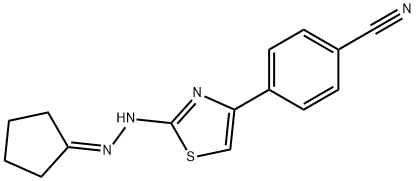Progeria is a genetic disorder that results in the appearance of premature aging. Genetically, progeria is characterized by a mutation in lamin A, which results in misshapen cell nuclei and DNA damage. Remodelin is a 2-thiazolylhydrazone derivative that, at 10 μM, improves nuclear architecture, chromatin organization, and survival of both cells lacking lamin A and cells from patients with progeria. Remodelin is an inhibitor of N-acetyltransferase 10 (NAT10), which acetylates both histones and microtubules. Mutation of NAT10 mimics the effects of remodelin on nuclear morphology, suggesting that these effects of remodelin require NAT10. Remodelin also has cytotoxic effects against some species of the fungus Candida.
Remodelin improves nuclear architecture, chromatin organization, and fitness of both human lamin A/C-depleted cells and Hutchinson-Gilford progeria syndrome (HGPS)-derived patient cells. N-acetyltransferase 10 (NAT10) inhibitor.
1) Larrieu?et al.?(2014),?Chemical Inhibition of NAT10 Corrects Defects of Laminopathic Cells; Science,?344?527
2) Larrieu?et al.?(2018),?Inhibition of the Acetyltransferase NAT10 Normalizes Progeric and Aging Cells by Rebalancing the Transportin-1 Nuclear Import Pathway; Sci. Signal.,?11?eaar5401
3) Balmus?et al.?(2018),?Targeting of NAT10 Enhances Healthspan in a Mouse Model of Human Accelerated Aging Syndrome; Nat. Commun., 9?1700
4) Cobb?et al. (2016),?Prelamin A impairs 53BP1 nuclear entry by mislocalizing NUP153 and disrupting the Ran gradient; Aging Cell,?15?1039
5) Ma?et al.?(2016),?Up regulation of NAT10 promotes metastasis of hepatocellular carcinoma cells through epithelial-to-mesenchymal transition; Am. J. Transl. Res.,?8?4215


